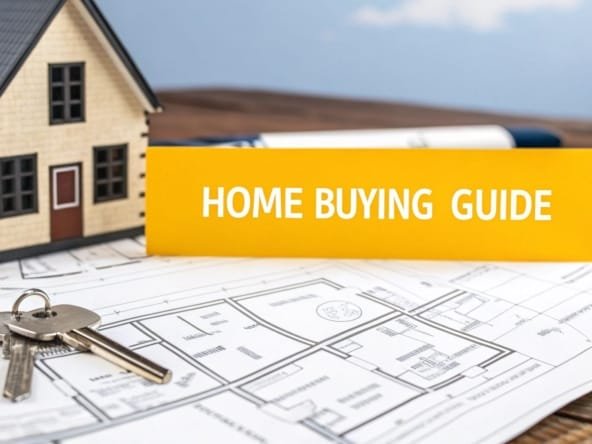Understanding Marrakech's Expense Landscape
Marrakech, the "Red City," entices visitors with its bustling souks, captivating architecture, and rich cultural experiences. Whether you're considering buying property, an expat searching for a new home, a real estate investor, or a business exploring commercial opportunities, understanding the cost of living is essential for sound decision-making. This goes beyond simply knowing the price of a tagine; it's about comprehending the overall financial landscape and how various elements influence your daily expenses in this vibrant city.
Historically, Marrakech's cost of living has been comparatively lower than European capitals, drawing expats and investors alike. However, with ongoing modernization and growing global appeal, understanding the city’s evolving expense landscape becomes even more vital. What was once affordable a decade ago may no longer be the case. Effective budgeting in Marrakech requires considering current prices and anticipating potential shifts based on market trends, infrastructure developments, and seasonal changes.
This guide breaks down the cost of living in Marrakech in 2025, offering valuable insights for both newcomers and long-term residents.
Essential Expenses
We'll examine the core components of your budget:
- Housing: Rental and purchase costs in different areas of the city.
- Food: Grocery prices for everyday items and the cost of dining out.
- Transportation: Public transport, taxis, and car ownership expenses.
- Healthcare: The cost of health insurance and medical services.
- Utilities: Average expenses for electricity, water, and internet.
Enhancing Your Marrakech Experience
Beyond basic necessities, we’ll explore the costs associated with enriching your life in Marrakech:
- Education: Options for schooling and associated fees.
- Childcare: Availability and costs of childcare services.
- Leisure Activities: Expenses for exploring Marrakech’s attractions and entertainment.
Financial Planning Considerations
Finally, we'll address essential financial aspects:
- Taxation: Understanding the local tax system.
- Administrative Costs: Costs for visas, permits, and other administrative processes.
By the end of this guide, you'll be equipped to plan your budget effectively, navigate Marrakech with confidence, and make informed decisions aligned with your financial goals.
1. Housing & Accommodation
Housing is the most significant expense you'll face in Marrakech. Whether you're a long-term resident, an expat renting, or a real estate investor, understanding Marrakech's housing market is crucial for effective budgeting. Prices vary considerably based on location and accommodation type, creating a diverse market.
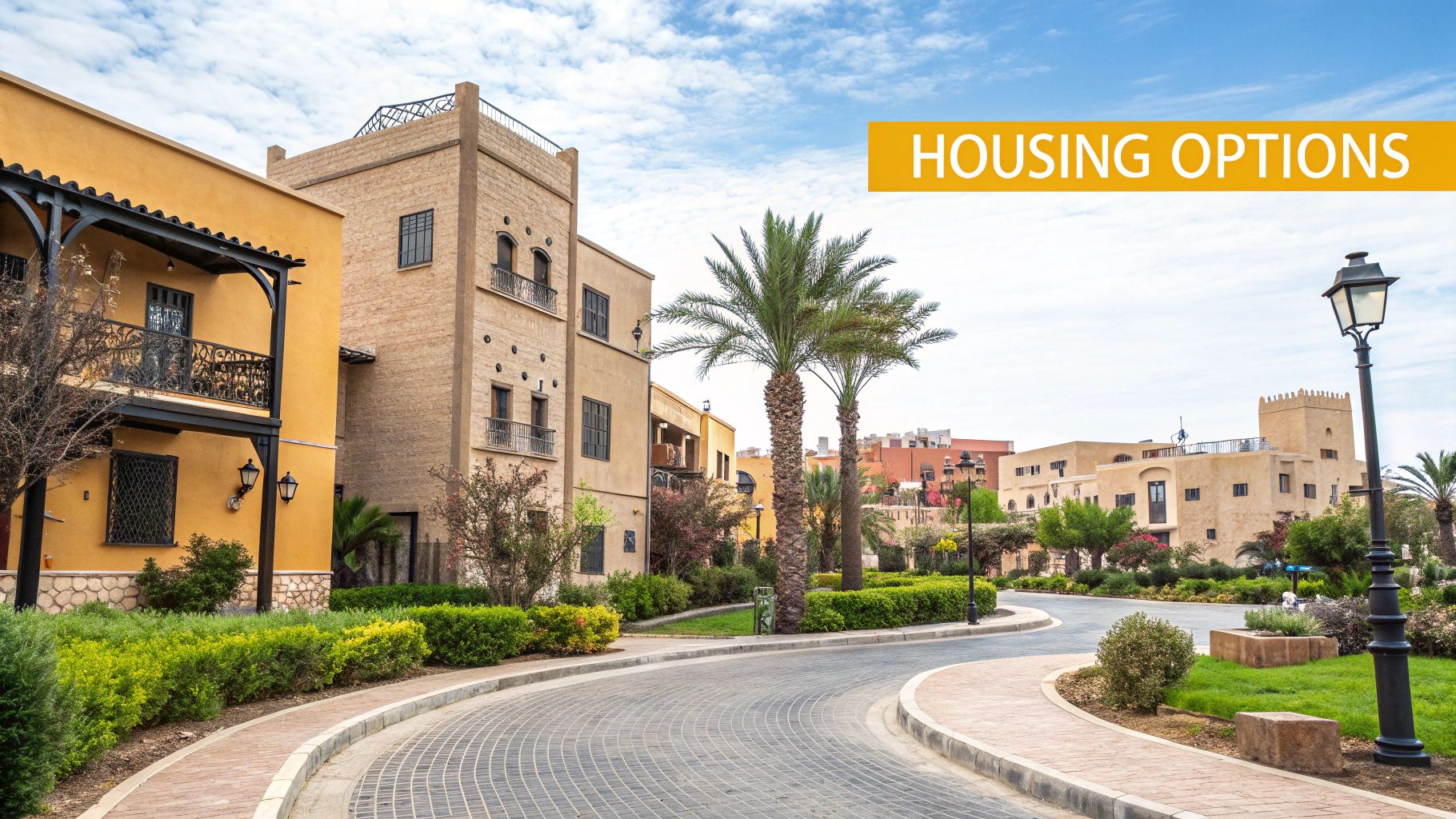
Marrakech offers a blend of traditional and modern housing. From restored riads in the medina to contemporary apartments in Gueliz and Hivernage, and even luxurious villas on the city's outskirts, each option provides a unique living experience.
Medina vs. Modern Districts
The medina, the old city, immerses you in Moroccan history and culture. Living within its walls offers unique charm, but may require compromising on modern conveniences. Gueliz and Hivernage, however, provide modern amenities and a more Westernized lifestyle, typically at a higher cost. For property listings, you can explore the RichLion Properties Sitemap.
Cost Breakdown
Expect to pay between 1,500 and 15,000 MAD per month for housing, depending on location, size, and quality. Here's a general guideline:
- 1-bedroom apartment in the city center: 3,500-5,000 MAD/month
- 3-bedroom apartment outside the center: 4,000-7,000 MAD/month
- Traditional riad rental in the medina: 7,000-12,000 MAD/month
Utilities (electricity, water, and internet) will add approximately 300-600 MAD to your monthly expenses. Air conditioning during the summer months can increase electricity bills.
Pros
- Affordability: Marrakech offers lower housing costs than many Western cities.
- Luxury Options: High-end villas and renovated riads are available at competitive prices.
- Unique Architecture: Experience living in a traditional riad or a modern apartment with Moroccan design elements.
Cons
- Quality Variations: Rental property quality can vary significantly, so inspections are essential.
- Premium on Modern Amenities: Apartments with Western-style amenities often come with higher price tags.
- Summer Cooling Costs: Air conditioning can be a substantial expense during summer.
Tips for Securing Accommodation
- Negotiate: Negotiating rental prices, particularly for long-term contracts, is standard practice.
- Reputable Agents: A reputable real estate agent can simplify the process and expand your property options.
- Location: Consider the location's proximity to essential amenities like supermarkets, transportation, and healthcare.
2. Food & Groceries
One of Marrakech's most attractive features is the cost of food, especially if you embrace local cuisine and shopping habits. This significantly influences the city's appeal for property buyers, renters, and investors, directly affecting their potential return on investment and overall quality of life. Understanding Marrakech's unique dual food economy is essential for maximizing your budget and enjoying the city’s vibrant culinary scene.
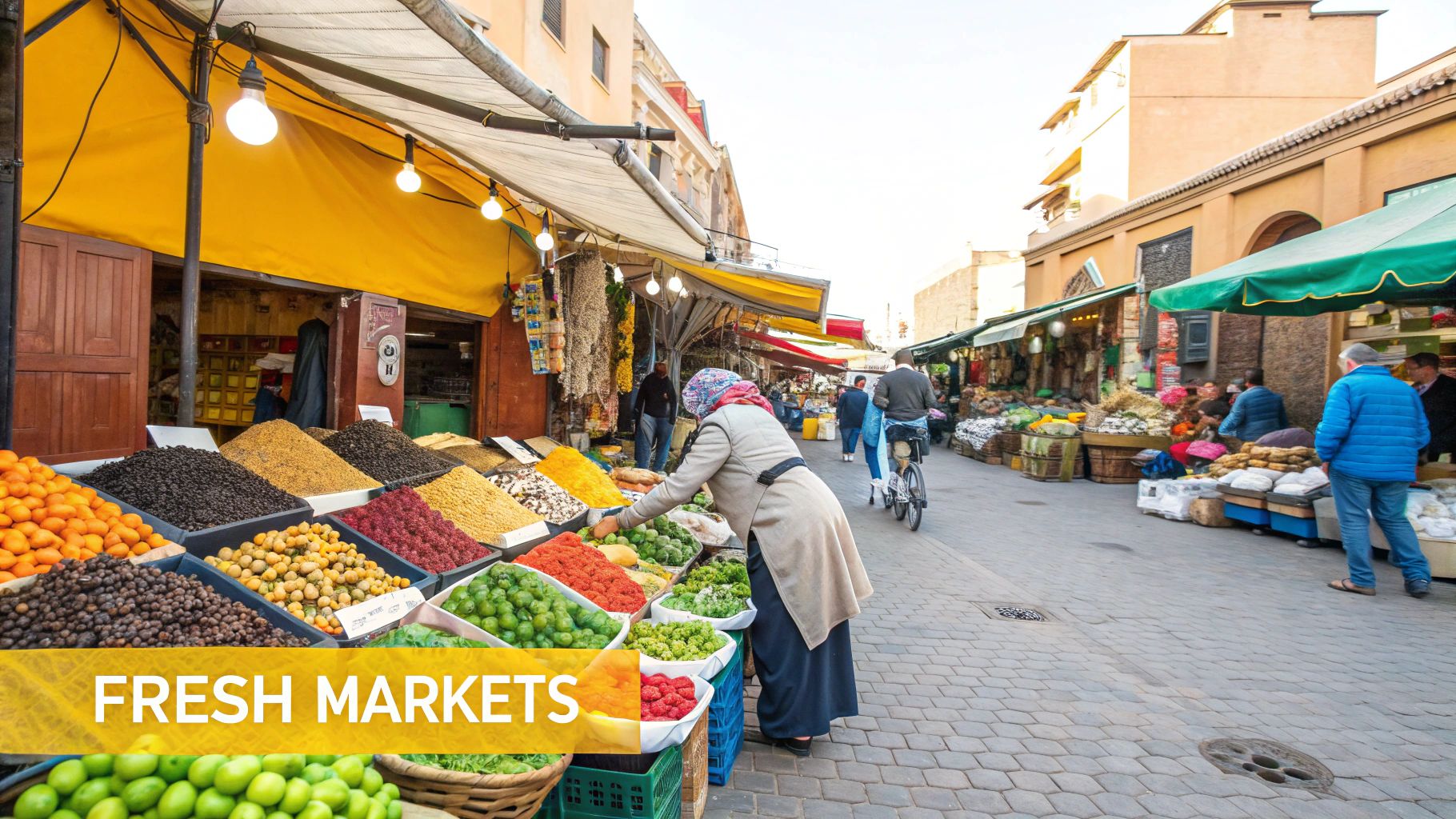
Marrakech boasts a two-tiered food system: traditional local markets and modern supermarkets catering to expats and tourists. This presents a unique opportunity for residents to strike a balance between cost and convenience.
The Local Advantage
Shopping at traditional souks and markets like the vibrant Mellah Market offers remarkably affordable prices on fresh produce, spices, meat, and staples like bread and grains. Seasonal price fluctuations translate to even greater savings during peak harvest times. Weekly souks, scattered throughout the city’s various neighborhoods, offer the best deals on produce. This system, deeply rooted in Moroccan culture, has sustained locals for centuries while providing a colorful, immersive experience for visitors.
Modern Convenience
Supermarkets like Carrefour and Marjane offer a broader selection of imported and packaged foods, with consistent pricing. While convenient, these products often come at a premium, sometimes costing two to three times more than in European countries. This price difference reflects import duties and the increasing demand for international products among expats and a segment of the Moroccan population.
Pros
- Extremely affordable local fruits, vegetables, and staples: A monthly grocery budget focused on local products can range from 800-1,500 MAD for one person.
- High-quality, fresh produce year-round: Marrakech's favorable climate and agricultural practices ensure a continuous supply of seasonal produce.
- Excellent value street food: Enjoy a delicious and satisfying street food meal for as little as 15-30 MAD, exemplified by the iconic food stalls of Jemaa el-Fnaa.
Cons
- Imported goods can be pricey: Imported products can cost two to three times more than in Europe, a considerable factor for those accustomed to specific international brands.
- Limited international product variety: While the selection is expanding, finding specific imported items can still pose a challenge.
- Language barrier: While many vendors speak some French or English, knowing basic Arabic numerals and phrases will significantly improve your bargaining power and overall shopping experience.
Tips for Navigating Marrakech’s Food Landscape
- Shop at weekly souks: Inquire with neighbors or your landlord for the schedule in your area.
- Learn basic Arabic: Simple numbers and phrases are invaluable for market bargaining.
- Utilize supermarkets: Carrefour and Marjane offer predictable pricing for packaged goods.
Understanding Marrakech’s food system is essential for anyone considering living or investing in the city. By embracing local markets, you can unlock a remarkably affordable and high-quality culinary experience, significantly enhancing your investment and daily life.
3. Transportation
Navigating Marrakech presents a captivating blend of traditional and modern transportation options, a crucial element in evaluating the cost of living. This dynamic system caters to diverse budgets and preferences, from the iconic petit taxis weaving through the vibrant souks to the convenience of ride-sharing applications. Understanding Marrakech's transportation landscape is essential for comfortably integrating into life in the city, whether as a resident or a visitor.
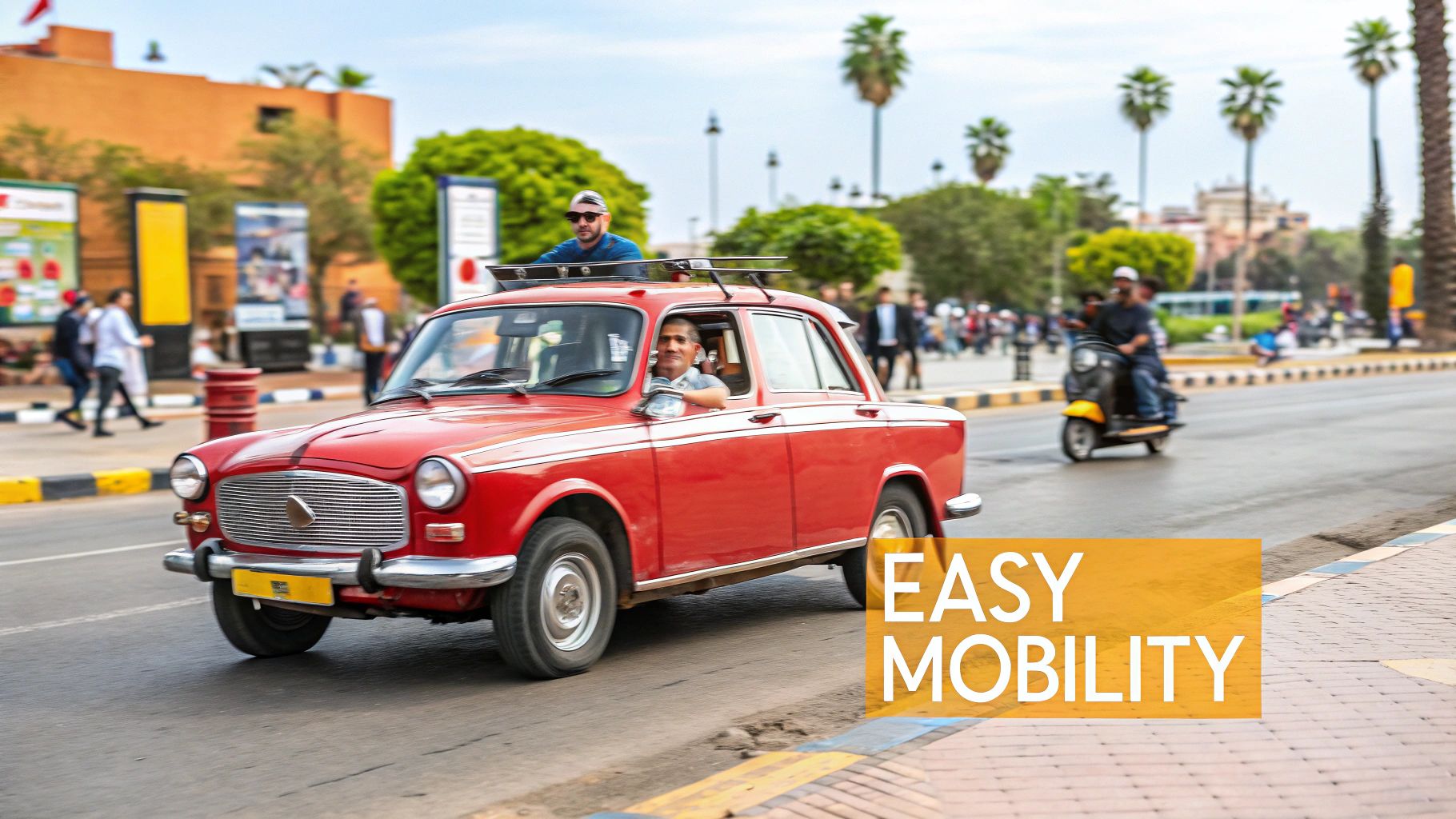
Marrakech boasts an affordable public transportation system, primarily consisting of buses. With fares starting from 4 MAD, these offer an economical way to travel. However, the bus network's limited infrastructure and infrequent schedules can be a disadvantage. For shorter intracity journeys, petit taxis (small red vehicles) are readily available. These are relatively inexpensive, especially when the meter is running. Negotiating the fare beforehand, however, is vital if the driver doesn't activate the meter. Grand taxis (larger, often shared taxis) and buses serve intercity routes, connecting Marrakech to other major cities such as Casablanca. For a broader view of real estate options across different Moroccan cities accessible via these transport links, you might be interested in: Our guide on Moroccan Properties.
The emergence of ride-sharing apps like Careem offers a contemporary alternative, providing a convenient and moderately priced service. This complements the traditional taxi system, offering residents a wider range of choices. Car ownership in Marrakech is generally unnecessary, particularly for those residing in the city center. Many daily necessities are within walking distance, further minimizing reliance on personal vehicles.
Pros
- Very affordable public transport (buses from 4 MAD)
- Walkable city center for many daily needs
- Petit taxis relatively inexpensive with meters
Cons
- Limited public bus infrastructure and schedules
- Taxi negotiation required without meters
- Traffic congestion in popular areas
Examples
- Petit taxi ride across city: 20-50 MAD
- Monthly transportation budget: 300-600 MAD
- Intercity bus to Casablanca: 80-120 MAD
Tips
- Insist on meter usage in petit taxis.
- Negotiate grand taxi fares before entering.
- Consider renting bicycles or scooters for local transportation.
Transportation costs in Marrakech are significantly lower than in many Western cities. The diverse range of options, from budget-friendly buses to the convenience of ride-sharing, allows residents and visitors to tailor their transportation expenses to their needs. The walkability of the city center further enhances the affordability and convenience of getting around. This combination of affordability and accessibility ensures transportation in Marrakech holds a key position in any cost-of-living assessment.
4. Healthcare
Access to quality healthcare is a crucial factor for anyone relocating to Marrakech. Whether buying property, renting, or investing, understanding the Moroccan healthcare system is vital for peace of mind and effective financial planning. Marrakech offers a two-tiered system, consisting of public and private options, each with varying levels of care and cost. Making informed decisions is paramount.
Public healthcare in Morocco, overseen by organizations like the CNOPS (Caisse Nationale des Organismes de Prévoyance Sociale), is heavily subsidized and affordable, even free for low-income residents. However, public hospitals and clinics often face challenges such as long wait times, overcrowding, and inconsistent quality of care. While public healthcare might be suitable for routine checkups or minor ailments, many expats and foreign investors opt for private healthcare.
Private clinics and hospitals in Marrakech, especially in the Gueliz and Hivernage districts, offer international-standard care. These facilities boast modern equipment and English-speaking staff. While more expensive than public options, the costs remain considerably lower than those in Western countries. Consultations typically range from 150-500 MAD, with general practitioner visits costing between 150-300 MAD. Even specialized procedures, like dental cleanings, remain affordable, ranging from 300-600 MAD.
Pros of Private Healthcare
- Affordable Care: Receive high-quality care at prices significantly lower than in many Western countries.
- High-Quality Clinics: Modern facilities and English-speaking staff cater to international patients. Reputable options include the Clinique Internationale de Marrakech and the Clinique Du Sud.
- Low-Cost Medications: Prescription drugs are generally cheaper than in Western countries, with many common medications available over-the-counter.
Cons of Healthcare in Marrakech
- Language Barriers: While private clinics often have English-speaking staff, navigating the public system or communicating with pharmacists may require French or Arabic.
- Variable Public Healthcare Quality: Public hospitals can be overcrowded and the quality of care can be inconsistent.
- Limited Specialist Care: For complex medical conditions or specialist consultations, travel to Casablanca, with its more specialized medical centers, might be necessary.
Practical Tips for Managing Your Healthcare
- International Health Insurance: Invest in a comprehensive international health insurance plan that covers Morocco. Companies like ALLIANZ and CIGNA offer suitable plans. Annual premiums generally range from 3,000-12,000 MAD, depending on coverage.
- Medication List: Keep a list of your medications in their French names or generic terms to avoid confusion at pharmacies.
- Research Private Clinics: Research reputable private clinics near your chosen location in Marrakech.
Morocco's two-tiered healthcare system continues to evolve, with increasing investments in private healthcare infrastructure driven by demand from expats and tourists. Understanding the nuances of this system is essential for anyone planning to live or invest in Marrakech. By choosing the right healthcare options and taking proactive steps, you can ensure your well-being while enjoying all that Marrakech offers.
5. Utilities & Services
Understanding utility costs is crucial for anyone considering a move to Marrakech, whether purchasing a property, renting, or making an investment. This breakdown of essential services and their associated expenses will give you a clearer understanding of potential monthly outgoings.
Utilities in Marrakech encompass electricity, water, internet, and mobile phone services. RADEEMA (Régie Autonome de Distribution d'Eau et d'Electricité de Marrakech) is the primary provider for both electricity and water, typically billing them together. While overall utility costs are generally lower than in Western countries, remember to account for seasonal fluctuations, particularly during the hotter summer months.
Understanding Your Utility Options
- Combined Billing: Electricity and water are usually billed together by RADEEMA.
- Internet Options: Several internet providers offer a variety of packages, including Maroc Telecom, Orange, and Inwi. These companies have played a key role in expanding internet access throughout Morocco.
- Mobile Services: Competitive mobile plans with generous data allowances are readily available.
- Cooking Gas: Bottled gas (butane) is the most common method for cooking.
Advantages of Utilities in Marrakech
- Lower Overall Costs: Compared to many Western countries, basic utilities in Marrakech are significantly more affordable.
- Competitive Mobile Plans: Enjoy affordable mobile services with substantial data allowances.
- Fiber Optic Availability: Newer neighborhoods often have access to high-speed fiber optic internet connections.
Potential Drawbacks to Consider
- Summer Surge in Electricity Bills: Air conditioning usage during the hot summer months can significantly impact electricity costs, sometimes tripling them. This seasonal variation is a critical factor for budgeting.
- Water Quality Concerns: While tap water is generally suitable for washing and cleaning, many residents choose bottled drinking water.
- Potential Service Interruptions: Occasional service interruptions can occur, though these are less frequent in newer developments.
Real-World Cost Examples
To give you a practical sense of expenses, consider these examples:
| Service | Estimated Monthly Cost (MAD) |
|---|---|
| Basic Utilities (85m² Apt) | 300-600 (excluding summer) |
| High-Speed Internet (12 Mbps+) | 300-500 |
| Mobile Plan with Data | 50-200 |
Practical Tips for Managing Your Utilities
- Prepaid Metering: Consider prepaid electricity meters to better manage and track your consumption, particularly during the summer.
- Solar Water Heating: Investing in solar water heating can significantly reduce long-term energy bills and is gaining popularity in Marrakech.
- Compare Telecom Providers: Research and compare internet providers to find the best coverage and deals for your location. Consider factors such as download speeds, data caps, and customer service.
Understanding these aspects of utilities in Marrakech will enable you to make informed decisions about your living arrangements and budget effectively. While the lower costs are appealing, incorporating seasonal variations and potential additional expenses, like bottled water, is essential for accurate financial planning.
6. Education & Childcare
Education and childcare are essential factors for families considering a move to Marrakech. These services significantly impact the overall cost of living and require careful consideration. Marrakech offers a wide range of options, from virtually free public schooling to high-end international institutions, catering to diverse needs and budgets. Understanding this educational landscape is key to making informed decisions for your family's future.
The Educational Spectrum
Marrakech's education system is primarily divided into three categories:
-
Public Schools: These schools are practically free, offering instruction in Arabic and French. While accessible, the language barrier can be significant for children who don't speak these languages.
-
Private Moroccan Schools: Offering a balanced bilingual curriculum in French and Arabic, these schools are a moderately priced alternative to international schools. They often integrate Moroccan culture and traditions into their educational approach.
-
International Schools: Offering internationally recognized curricula, such as the American, British, French, and International Baccalaureate (IB) programs, these schools deliver a high-quality education comparable to Western standards. However, this quality comes at a premium cost.
Cost Breakdown
The annual cost of education in Marrakech varies considerably:
-
International Schools: Annual tuition ranges from 50,000 to 90,000 MAD (approximately $5,000 – $9,000 USD). This is a considerable investment, comparable to private school tuition in many Western countries.
-
Private Moroccan Schools: Annual fees typically range from 15,000 to 40,000 MAD (approximately $1,500 – $4,000 USD), presenting a more budget-friendly option for bilingual education.
-
Childcare/Nanny Services: Full-time nannies are readily available and comparatively affordable, costing between 2,000 and 4,000 MAD (approximately $200 – $400 USD) per month. This can be a substantial benefit for working parents.
Pros and Cons of Education in Marrakech
Here’s a quick overview of the advantages and disadvantages of Marrakech's education system:
Pros:
- Availability of high-quality international education meeting globally recognized standards.
- Good value for bilingual education in private Moroccan schools compared to Western counterparts.
- Affordable childcare and readily available nanny services.
Cons:
- International school fees comparable to Western private school tuition.
- Competitive admissions for top-rated schools, often requiring applications 6-12 months in advance.
- Significant language barrier in public schools for non-French/Arabic speakers.
Practical Tips for Navigating the Education System
-
Start the application process for international schools well in advance (6-12 months), especially for popular schools like the American School of Marrakesh (ASM), École Jacques Majorelle, and ELBILIA International School, which often have waiting lists.
-
Consider the advantages of language immersion offered by local private schools, a valuable asset for children growing up in a multilingual environment like Marrakech.
-
Supplemental education through part-time tutoring is accessible and relatively affordable, costing between 70 and 150 MAD (approximately $7 – $15 USD) per hour. This can be helpful for children adjusting to a new curriculum or needing extra support in specific subjects.
Why Education Matters for Residents and Investors
Understanding the education and childcare landscape is vital for anyone considering Marrakech. For families, these services directly impact their monthly budget and their children's future. For investors, the presence of reputable schools increases a location's desirability, influencing property values and rental demand. Whether you are a property buyer, renter, or investor, the quality and availability of education are crucial in evaluating Marrakech's suitability as a place to live and invest.
7. Entertainment & Leisure
Marrakech pulsates with vibrant energy, offering a diverse range of entertainment and leisure activities. This dynamic environment makes it an attractive city for residents and visitors alike, significantly contributing to its appeal for property buyers, expats, and investors. It's also a key factor to consider when assessing the cost of living.
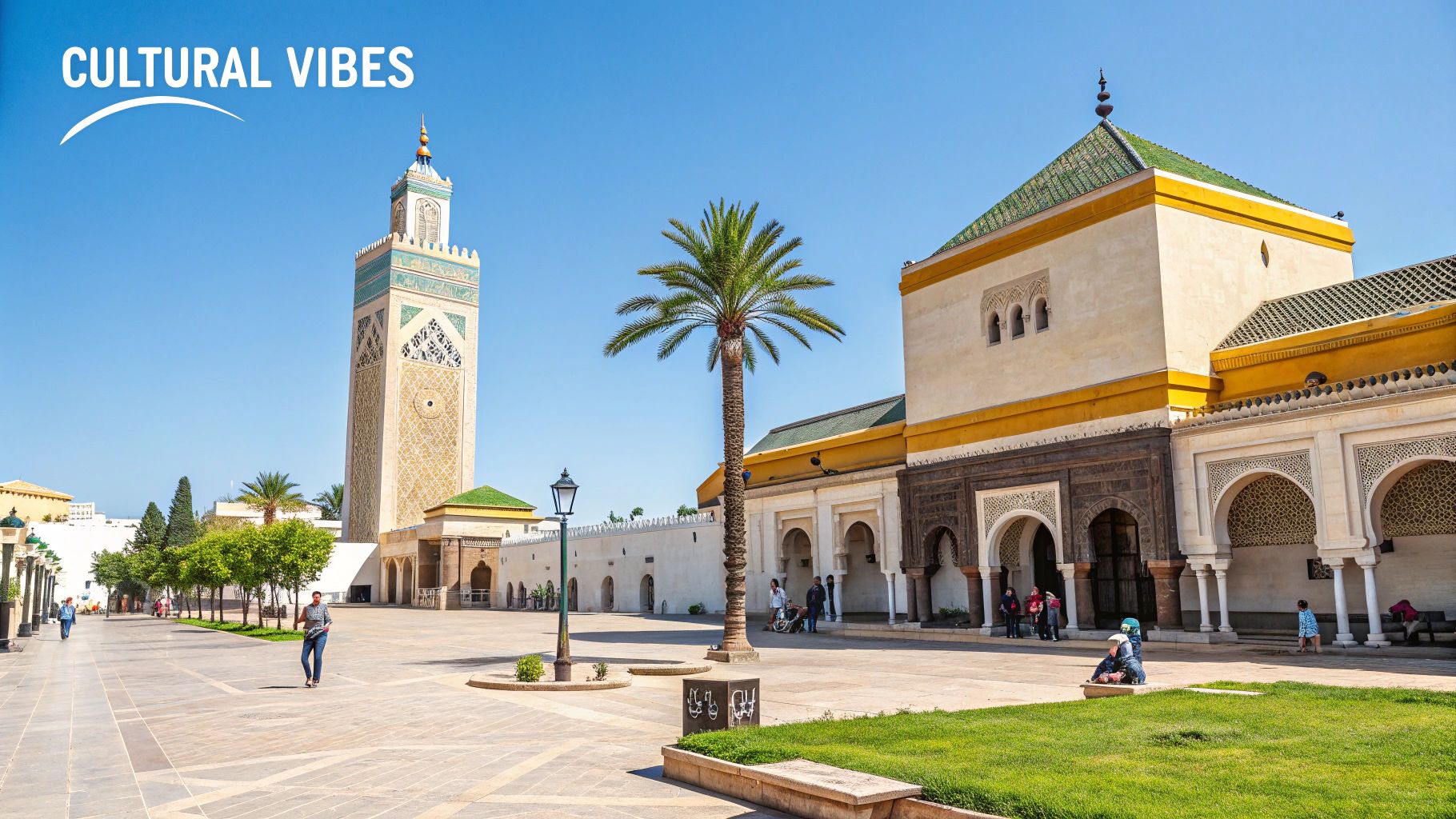
From exploring ancient souks and palaces to enjoying world-class dining and exhilarating outdoor adventures, Marrakech caters to a wide spectrum of tastes and budgets. The city’s entertainment scene seamlessly blends traditional Moroccan culture with modern influences.
Exploring Marrakech's Rich History and Culture
Historic sites like the Bahia Palace and Ben Youssef Madrasa offer glimpses into the city’s rich past, with entrance fees typically ranging from 10-70 MAD for residents. Modern venues such as the Yves Saint Laurent Museum (Jardin Majorelle) and MOMA Marrakech showcase contemporary art and design.
The proximity to the Atlas Mountains and the Agafay Desert provides further options. Weekend hikes, camel rides, or relaxing in a traditional hammam are all readily accessible. There truly is something for everyone.
The Cost of Leisure in Marrakech
The cost of leisure activities can vary greatly. Exploring the souks and enjoying street food can be incredibly affordable. However, tourist-oriented establishments and fine dining experiences often come with premium pricing. A fine dining meal can range from 200-500+ MAD per person, while a cinema ticket typically costs between 50-80 MAD. Gym memberships cater to various budgets, ranging from 300-800 MAD per month.
Pros of Entertainment & Leisure in Marrakech
-
Abundant free or low-cost cultural experiences: Exploring the medina, visiting Djemaa el-Fna square, and wandering through the souks offer rich cultural immersion without cost.
-
Affordable access to hammams and traditional experiences: Enjoying a traditional hammam is a quintessential Marrakech activity and relatively inexpensive.
-
Proximity to the mountains and desert for weekend excursions: Marrakech’s location makes it easy to escape the city for outdoor adventures.
Cons of Entertainment & Leisure in Marrakech
-
Tourist-oriented entertainment carries premium pricing: Be prepared to pay higher prices at establishments catering primarily to tourists.
-
Dual pricing: Be aware that some activities have different pricing structures for locals and foreigners.
-
Expensive alcohol: Due to cultural restrictions and taxation, alcohol can be expensive.
Tips for Enjoying Marrakech's Entertainment
-
Visit major sites during off-peak hours: Avoid crowds and enjoy a more immersive experience by visiting popular attractions outside of peak times.
-
Use resident cards when available for local pricing: Take advantage of resident discounts whenever possible to save on costs.
-
Explore cultural centers like Dar Bellarj for free exhibitions: Discover local art and culture without breaking the bank by visiting free exhibitions.
You might be interested in: Our sitemap for more information related to properties and living in Morocco.
The diversity and accessibility of entertainment options significantly enhance the quality of life in Marrakech. This factor is crucial for anyone considering buying property, renting, or investing in the city, contributing to its allure as a dynamic and desirable location. Whether seeking vibrant nightlife, tranquil cultural experiences, or thrilling outdoor pursuits, Marrakech offers something for everyone.
8. Taxation & Administrative Costs
Navigating the financial aspects of relocating to a new country is a critical step for any prospective resident. For those considering Marrakech, a clear understanding of taxation and administrative costs is essential for effective budgeting and a seamless transition. While Marrakech generally boasts a lower cost of living than many Western countries, administrative procedures and associated fees can sometimes present unforeseen challenges. This section will explore the key elements of taxation and administrative costs in Marrakech, providing practical guidance for potential residents and investors.
Residency, banking, and tax obligations represent the core components of administrative costs in Marrakech. Morocco employs a progressive tax system, meaning individuals with higher incomes pay a larger percentage of their earnings in taxes. Income tax rates for residents can range from 0% to 38%. However, a significant advantage for temporary residents (those staying less than 183 days) is the exemption from taxes on their worldwide income.
Key Administrative and Tax Considerations
- Residency Permit (Carte de séjour): Required for stays exceeding 90 days. Fees apply for both initial applications and subsequent renewals.
- Banking Services: Local banks offer a variety of services. However, remember to factor transaction fees and monthly maintenance fees into your budget. Consider banks like BMCE Bank and Attijariwafa Bank.
- Income Tax: Progressive rates from 0-38% apply to residents. Non-residents are typically taxed only on income sourced within Morocco. Consult the Direction Générale des Impôts (DGI), the Moroccan tax authority, for detailed information.
- Property Tax: Comparatively low, usually between 0.5% and 1% of the property's assessed value annually.
Advantages of the Marrakech Tax System
- Tax Exemption for Temporary Residents: A considerable benefit for those staying less than six months. No tax is levied on income earned outside of Morocco.
- Low Property Taxes: Compared to many Western countries, property taxes in Marrakech remain affordable.
- Reasonable Administrative Fees: The base cost for many administrative services is generally lower than in numerous developed nations.
Potential Challenges to Consider
- Administrative Complexity: Navigating administrative procedures can be challenging and often necessitates local assistance.
- Document Costs: Be prepared for expenses related to document translation and certification for official purposes.
- Banking Fees: While the cost of services is generally lower, banking fees can sometimes be higher than anticipated.
Illustrative Examples of Costs
- Residency Permit Application: Approximately 100 MAD, plus additional expenses for necessary supporting documents, such as medical certificates and passport photos.
- Property Tax: For a property valued at 1,000,000 MAD, the annual property tax could fall between 5,000 MAD and 10,000 MAD.
- Banking Fees: Monthly account maintenance fees can range from 15 MAD to 50 MAD depending on the specific bank and account type.
Practical Tips for Managing Costs
- Budget for Support: Allocate funds for document translation and potentially legal assistance. Engaging a local lawyer or administrative assistant can streamline processes and help avoid costly errors.
- Tax Residency Consultation: If your stay in Morocco is expected to exceed 183 days, consult a tax advisor to understand your tax obligations fully.
- Local Banking: Open a local bank account to minimize international ATM fees and facilitate easier transactions.
Importance of Financial Planning
A thorough understanding of taxation and administrative costs is paramount for anyone intending to invest, live, or conduct business in Marrakech. Accurate budgeting and planning are essential for a successful transition and mitigating unexpected financial burdens. This aspect of the cost of living is frequently overlooked, making it a vital component of a comprehensive guide to living in Marrakech. Proactive planning and informed decision-making are key to a smooth and financially sound experience in Marrakech.
8-Factor Expense Comparison for Marrakech
| Expense Factor | 🔄 Complexity | ⚡ Resources | 📊 Expected Outcomes | 💡 Ideal Use Cases | ⭐ Advantages |
|---|---|---|---|---|---|
| Housing & Accommodation | Varied market; negotiation often required | 1,500-15,000 MAD monthly; extra utility costs | Unique living experiences; cost-effective compared to Western cities | Long-term rentals; expats weighing charm vs modern air | Affordable luxury; diverse property options |
| Food & Groceries | Dual market (local vs imported); savvy shopping needed | 800-1,500 MAD monthly for local products | High-quality, fresh produce with excellent value | Budget-friendly dining; exploring street food | Very affordable local foods; vibrant market culture |
| Transportation | Mixed system with taxis, buses, and ride-sharing; negotiation common | Roughly 300-600 MAD monthly | Diverse transit options; ease of city travel | Daily commutes; exploring walkable city center | Low-cost public transport; accessible travel options |
| Healthcare | Two-tier system; variable quality between public and private | Varies: GP 150-300 MAD; insurance 3,000-12,000 MAD yearly | International-standard care at below Western prices | Expat use with private insurance; routine check-ups | Affordable private clinics; low-cost medications |
| Utilities & Services | Seasonal pricing variations; bundling is common | About 300-600 MAD monthly; internet 300-500 MAD monthly | Consistent services with competitive pricing | Budget management with prepaid metering; urban setups | Lower costs; competitive telecommunication plans |
| Education & Childcare | Wide variance; limited international school spots | Annual fees from 15,000-90,000 MAD; childcare 2,000-4,000 MAD monthly | Access to quality education and varied curricula | Families seeking international curricula; affordable childcare | Good value in private schools; cultural exposure |
| Entertainment & Leisure | Dual pricing for locals vs tourists; variable pricing | Variable outlay: cinema 50-80 MAD; dining 200-500+ MAD | Rich cultural and outdoor experiences; lively nightlife | Cultural exploration; leisure on varied budgets | Abundant free/low-cost activities; unique cultural sites |
| Taxation & Administrative Costs | Bureaucratic; may require translation/legal help | Minimal fees: ~100 MAD for residency, small banking fees | Simplified taxes for temporary residents; progressive tax system | Residents managing bureaucracy; strategic tax planning | Affordable fees; beneficial tax treaties |
Making Marrakech Affordable
Understanding Marrakech's diverse cost landscape is crucial for maximizing your travel experience while keeping your budget in check. From accommodation and groceries to getting around and enjoying your leisure time, navigating the various expense categories requires a balanced approach. Exploring local markets for fresh produce, using the efficient public transport system, and discovering the city's rich cultural heritage through budget-friendly activities are key to enjoying Marrakech without breaking the bank. By understanding how these cost factors interact, you can create a lifestyle that aligns with your financial goals.
Putting these principles into action involves careful planning and research. When considering where to stay, explore a range of options, from traditional riads to modern apartments, keeping in mind both location and amenities. For daily expenses, familiarize yourself with local markets and smaller grocery stores to find better deals on food and essentials. Take advantage of the affordable public transport network and consider walking or cycling for shorter distances. Explore free or low-cost cultural experiences such as visiting historical sites, gardens, and attending local festivals.
Adapting to the local lifestyle is another important aspect of managing costs. Learning some basic Arabic phrases can be helpful when navigating markets and interacting with locals. Embrace the Moroccan tradition of respectful bargaining, especially in the souks. Be open to trying local cuisine, which is often more budget-friendly than international options. By observing local customs and practices, you can integrate seamlessly into the community and gain valuable insights into cost-effective living.
Ongoing trends, like the rising popularity of co-working spaces and remote work opportunities, are also influencing the cost of living in Marrakech. Future developments in infrastructure and tourism are expected to create new economic opportunities and potentially impact housing and rental prices. Staying informed about these trends is essential for making sound decisions about your long-term financial planning in Marrakech.
Key Takeaways
- Embrace Local Life: Make the most of the souks, public transport, and free cultural attractions.
- Plan and Research: Compare accommodation options, grocery prices, and transportation costs.
- Adapt and Learn: Engage with the local culture and language for a more immersive and affordable experience.
- Stay Informed: Keep track of ongoing trends and future developments in the Marrakech market.
Ready to navigate the Marrakech property market with confidence and find the perfect property for your budget and lifestyle? Rich Lion Properties offers expert guidance and comprehensive services for buying, renting, and selling properties across Morocco. From luxurious riads to budget-friendly apartments, we provide tailored solutions and local insights to ensure a seamless and transparent transaction. Let us help you unlock the potential of the Moroccan real estate market. Visit us at Rich Lion Properties today.



